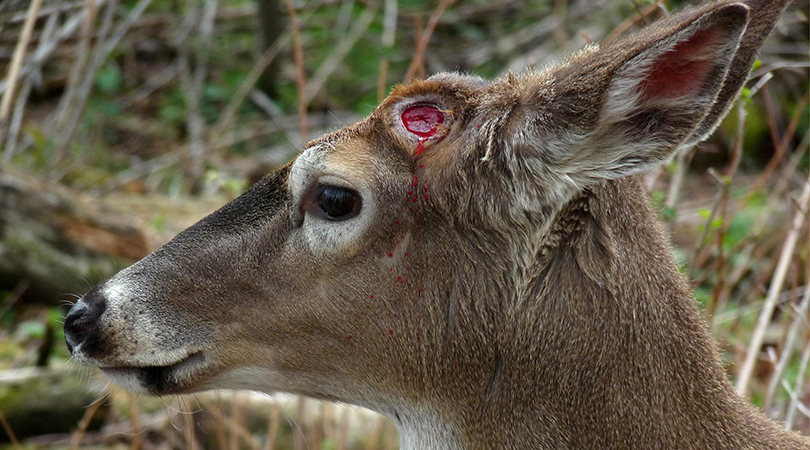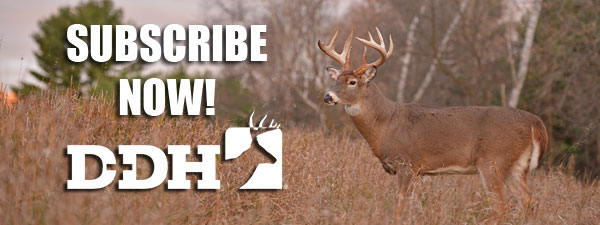D+DH In-Depth is our premium, comprehensive corner on America’s No. 1 game animal. In this graduate-level course, we’ll teach you about deer biology, behavior, and ultimately, how to become a better hunter. Want to be the first to get our premium content? Become a D+DH Insider for FREE!
A post-season search for “white gold” can uncover clues that might make you more effective in the whitetail woods come fall.
“What do you think about this buck?” I asked my hunting pal Greg as I showed him a digital photo I’d snapped of the deer peeking from heavy cover that morning. Greg zoomed in on the half-obscured buck before giving me his whitetail court verdict.
“I’ve got that buck’s shed antlers,” he replied. “From the antlers, my trail cameras and your photo, I say give him another year. The good news is that he’s in the same rut area as last year so we know his favorite hangout.”
Shed antler hunting is becoming more and more popular with whitetail hunters — and for good reasons. Geocache-like satisfaction aside, shed antlers and the associated intel can help form the foundation for a solid whitetail game plan. Everything associated with the search for “white gold” has the makings for a great whitetail season ahead if you analyze and utilize the information wisely.
Senior Citizen Facility
The excitement of picking up a shed antler from its frosty resting place can be topped only by the first time you place your hands on a buck you just recovered. Even though you don’t get to savor the backstraps of the buck whose shed you just found, you do get to cherish the shiny, shed antler for decades ahead. You also can use that antler and others you discover as a basis for the property’s buck age structure evaluation.
Whether you manage thousands of acres or a 50-acre pasture — or even hunt a parcel of public land — you can use your shed antler discoveries as a basis for buck maturity assessment. If you hunt only public lands, you need to keep in mind you won’t be getting the full picture, but any shed antler hunting is better than a day on the couch watching overseas soccer … unless there is a stadium-emptying fight, of course. And the information you glean can be helpful when developing a game plan for the upcoming season.

It’s almost a guarantee you’ll pick up more shed antlers from young bucks, and your larger finds will be few and far between. It’s the pyramid principle. There are more young individuals in most wildlife populations, so the bottom of the pyramid is filled with the younger generation and the fewer, older individuals make up the upper, smaller portion of the pyramid.
Lay out your shed antler finds from the spring, and if you have a pile of small shed antlers two to three times larger or more than your pile of antlers from mature bucks, you are in the norm. To determine if your antlers actually fell from a senior citizen — a buck 4.5 years or older — look for mass, tine length and even extra points.
Here’s where your trail camera pictures also come into play. Review them to see if you have images of the bucks sporting the antlers you now have in hand. Skinny bucks with doe-like faces are the freshman class. Roman-nosed bucks with sagging bellies and front ends that look larger than their hindquarters are the graduates.
Property size, hunting pressure and regional whitetail densities all factor into how many mature bucks should be on a piece of property. Even so, you should have a couple of older bucks in the neighborhood if your senior citizen facility is operating on norm. If not, you might want to consider another management plan or changing hunting locations.
During a March hike this past spring, I picked up more than a dozen shed whitetail antlers. Most were from bucks ranging from 1½ to 3½ years of age. Three were from bucks 4½ years or older. Discoveries such as that signify a healthy age structure for a property that receives annual pressure from multiple hunters.
Recruitment
Your shed antler finds will give you some indication of the age structure of the bucks on your hunting property, but what about recruitment? You need to evaluate the density of the overall herd as well. Do you have too many deer, the right amount or too few? Before the spring green-up you’ll have an open view, even in woodland settings, to see through the brush and into openings for accurate deer counts.
As you hike around your hunting area, take notes on the doe groups you see and, if possible, how many fawns are within the group. Fawns are critical to the ongoing well-being of a deer herd. One or two fawns per doe equals ideal recruitment. Since it’s normal for a few to become statistics expect that number to fluctuate, but if you notice an abnormally high number of missing fawns it could indicate a problem.
Planning several shed hunting outings — recording deer counts on each trip — will give you several tallies to average for an accurate estimation. And your documentation doesn’t just have to occur during shed hunting season. By compiling counts from field observations and documenting them annually throughout the seasons you can begin to see reproduction success, seasonal shifts in population and overall trends.

You can bolster those statistics with trail camera intel. By placing trail cameras in the same locations year after year and creating a filing system, you will see reoccurring trends. Compare those images with your habitat and firsthand deer observations.
Lastly, don’t be just a deer watcher. Inspect food plots, browse and other food sources in the hunting area. If you begin to notice ravaged fields, a definite browse line or even a deer exodus to the neighboring property you might have a hungry herd. Lots of deer creates good hunting as long as the land has the carrying capacity to support all of its residents.
On one of my recent shed antler excursions, I was more than surprised by the number of deer on a property. I had permission to hike a private parcel, but it abutted up against an even larger public area. I did find a good number of antlers, but nothing compared to the amount of does and fawns that littered the fields and edges. After my hike I stopped by to talk to the landowner and informed him that he might want to open up more hunting opportunities to bring the buck-to-doe ratio back in line with regional norms. Hopefully, he will take my advice and allow more hunting opportunities for local hunters, especially youths, to help control the population.
Winter Casualties
Remember the missing fawns? Your shed hunting excursions will expose the savageness of winter and overall viciousness of Mother Nature. Don’t freak out if you find a dead deer here and there, even a buck, while hiking for shed antlers. Deer are a prey species and there will be a few casualties. Winter is tough on fawns and they account for the most. They’re young, weak and vulnerable, and coyotes and wolves target them, so expect to find the remains of a few dead fawns while shed hunting.
You should also expect to find a buck or two with a weight loss issue. Bucks average more than 20 percent weight loss during the rut. An early onset to winter doesn’t give them a chance to recuperate and they could succumb to winter stress or predation. Or they might have been hit by a bullet or broadhead, and suffered a lingering death. Auto collisions and other accidents could also account for a few fatalities.
But you really should become concerned if you stumble across carcass after carcass. Only you will know how many is too many dead deer, depending on property characteristics. If you suspect foul play in a big way, reach out to a local state wildlife agency biologist for answers. You need to determine if the situation has any core problems you can remedy with habitat improvements or other management decisions.

Your finds could also help you next hunting season. If you’ve had your eyes on a trophy buck and suddenly he’s off the radar, you don’t want to be guessing about his whereabouts. Finding him dead during shed season alleviates lots of worry later, although it doesn’t make the discovery any less depressing.
On one March hike with my daughter we canvassed a cottonwood bottom for sheds, but as the fog lifted my heart sank. There in the middle of the strip of timber was the remains of a massive 4×4 buck I’d hunted the previous fall. I had hoped to pursue him again the coming season, but the coyotes had gotten to him first.
Putting it all Together
Your game plan really comes together in the form of deer clues left behind as you peek behind the interior curtain of a property. You’ll begin to unravel the year-long lifestyle of whitetails, but during the rut bucks, particularly, leave clues as to where they spend most of their time. There’s no need to stay out of bedrooms, food plots or transition areas during this time of year. Be discreet, but go all in and investigate those places you designate as off-limits the rest of the year. You’ll bump some deer, but record the numbers and then take notes on what you find.
Be especially focused on scrape lines, rub lines and where these buck indicators lead — most likely to secretive bedding barracks, food sources and hopefully new ambush locations along their routes. They should also give up a few antlers along the way.
Use your GPS or even better yet, satellite images, such as those utilized by the ScoutLook Weather hunting app and others, to mark all buck sign. When you pull up the image later, the string of clues oftentimes shows an obvious pattern that might come in handy for future ambush setups.
This past spring, I received permission to scout a new property with tangled whitetail topography. While tunneling through the trails to find antlers, I came across numerous rubs and scrapes along hidden routes. Each find was followed by a ScoutMarX notation on my hunting app for future reference.
As for the off-limits buck I was told to pass on during my hunt; I returned to the same stand knowing more than one mature buck was on the property. That was obvious from the shed antler history and trends noted from annual observations. The next morning before sunrise an old-timer showed up, and this time I didn’t have to question if he was on the hit list. His antler mass told the story, and I put my Mathews into play.
— Mark Kayser is a hardcore whitetail hunter and outdoors communicator from Wyoming.
Want to be the first to get our premium content? Become a D+DH Insider for FREE!


